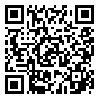BibTeX | RIS | EndNote | Medlars | ProCite | Reference Manager | RefWorks
Send citation to:
URL: http://jdisabilstud.org/article-1-2680-en.html
Background & Objectives: Depression is a mental disorder whose main characteristic is having a state of anxiety in different situations for at least two weeks. Traumatic experiences and a disturbing family environment can be effective in the onset of depressive symptoms, so attachment injuries are among the main underlying factors in the formation of a depressive disorder. Positive psychological capital is a positive psychological state of life that includes productivity, hope, optimism and self–efficacy. Social support has been cited as a predictor of hope and an increased ability to cope with stress and difficult situations. Adolescents with hearing impairments due to physical disabilities and the resulting deprivations are often unable to form social and mutual relationships with their peers, and their emotional and social adjustment is difficult. Therefore, the quality of attachment with peers is low. This study aimed to develop a model for depression in hearing–impaired people based on attachment styles and psychological capital mediated by perceived social support.
Methods: This research is a correlational analytic study using structural equation modeling. The study’s statistical population comprised 1466 people with hearing impairments with active files in the Deaf Center of Rasht City, Iran, under the auspices of the Welfare Organization of Gilan Province, in 2020. A sample of 305 people was selected from the study population using a simple random sampling method. According to Klein (1998), if structural equation modeling is used, about 15 samples are needed for each manifest variable. Since there were 15 manifest variables in this study, 255 people were needed, but considering the possible dropout, 305 people were selected as the final sample. The inclusion criteria were mild to profound hearing impairment, no history of serious physical or psychological problems, no use of psychological medication, and no use of psychological therapies. The exclusion criteria included providing incomplete information and not answering all the questions of the questionnaires. Data collection tools were Psychological Capital Questionnaire (Luthans et al., 2007), Multidimensional Perceived Social Support Scale (Zimet et al., 1988), Beck Depression Inventory–II (Beck et al., 1996), and Parent–Peer Attachment Scale (Armsden & Greenberg, 1987). For data analysis, mean and standard deviation indices were used at the level of descriptive statistics. Inferential analysis of data was performed using the Pearson correlation coefficient and structural equation modeling in SPSS software version 22 and LISREL version 8.80. The Bootstrap test was used to evaluate the mediating relationships. The significance level of the tests was considered 0.05.
Results: Findings showed that parental attachment (β=0.64, p<0.001) and psychological capital (β=0.61, p<0.001) had a positive and direct effect on perceived social support. Also, parental attachment (β=–0.38, p<0.001) and psychological capital (β=–0.41, p<0.001) had an inverse effect on depression. The indirect effect of parental attachment on depression was equal to β=–0.52 (p<0.001). The indirect effect of psychological capital on depression was equal to β=–0.49 (p<0.001). Good fit indices also supported the optimal fit of the research model with the collected data (RMSEA=0.035, AGFI=0.93).
Conclusion: Based on the findings of this study, perceived social support has a mediating role in the relationship between attachment styles and psychological capital with depression in people with hearing impairment.
| Rights and permissions | |
 |
This work is licensed under a Creative Commons Attribution-NonCommercial 4.0 International License. |




